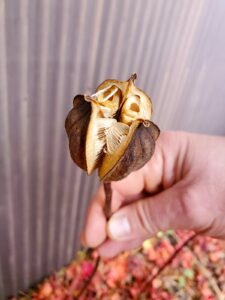What an astonishing discovery at a temple near the magnificent site of World Heritage Koyasan (Japan) last Sunday! …Look at these hundreds of perfectly stacked seeds
Cardiocrinum cordatum, commonly known as the heart-leaved lily or Japanese giant lily, is a striking perennial plant native to East Asia (1-3), including Japan. It is cherished for its towering stature, reaching up to 2 meters, and its elegant, trumpet-shaped flowers that bloom in shades of creamy white with hints of green. The plant’s large, heart-shaped leaves make it an attractive feature even when not in bloom. Often found in shaded forested areas, Cardiocrinum cordatum is a symbol of natural beauty and tranquility, harmonizing perfectly with the serene ambiance of Japanese temple gardens.
The seed dispersal strategy of Cardiocrinum cordatum is truly remarkable. Its seed capsules split open to reveal lightweight, winged seeds that are expertly designed to catch the wind, allowing them to glide and disperse over great distances (1,2). This ingenious mechanism ensures the plant’s survival and propagation across the forested landscapes it calls home.
References:
(1) OHARA, M., NARUMI, T., YOSHIZANE, T., OKAYASU, T., MASUDA, J. and KAWANO, S. (2006), 7: Cardiocrinum cordatum (Thunb.) Makino (Liliaceae). Plant Species Biology, 21: 201-207. https://doi.org/10.1111/j.1442-1984.2006.00166.x
(2) Kondo, T., Sato, C., Baskin, J.M. and Baskin, C.C. (2006), Post-dispersal embryo development, germination phenology, and seed dormancy in Cardiocrinum cordatum var. glehnii (Liliaceae s. str.), a perennial herb of the broadleaved deciduous forest in Japan†. Am. J. Bot., 93: 849-859. https://doi.org/10.3732/ajb.93.6.849
(3) https://www.worldfloraonline.org/taxon/wfo-4000006679












